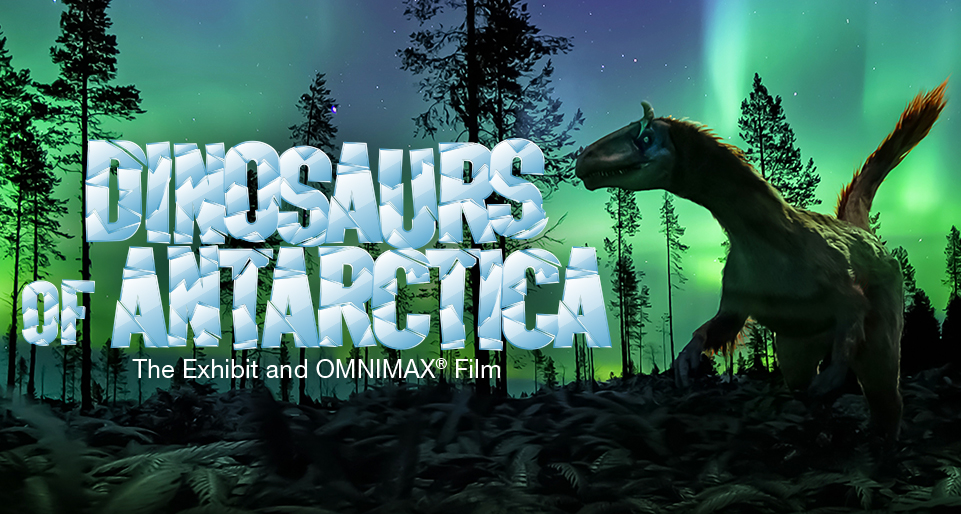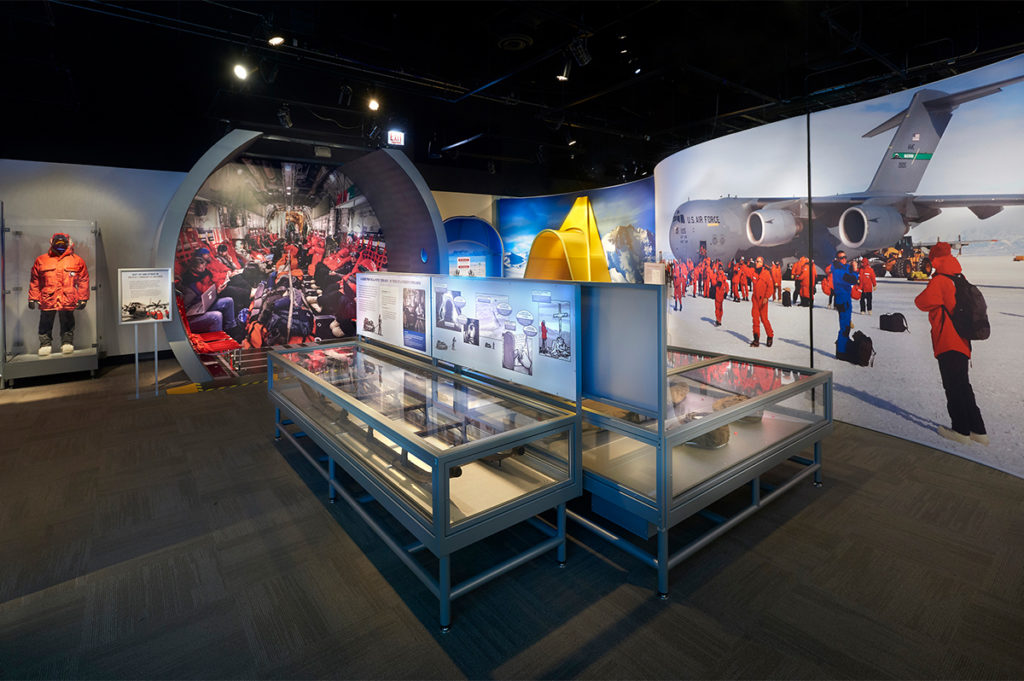
Press Room
FOR IMMEDIATE RELEASE: August 11, 2022
Dinosaurs have never been cooler
Dinosaurs of Antarctica exhibition and OMNIMAX® film open at Cincinnati Museum Center Oct. 14
CINCINNATI –Dinosaurs have always been cool, but they’ve never been this cool. Cincinnati Museum Center’s newest exhibition and OMNIMAX® film reveal the prehistoric history of Antarctica and its dinosaur inhabitants in exciting detail. The unique offering from CMC delivers a content-rich immersive exhibition and a perfectly matched OMNIMAX® film that transport you to Antarctica in the age of dinosaurs. Dinosaurs of Antarctica opens October 14.
Dinosaurs of Antarctica take you back in time to a land we wouldn’t recognize today. A land where massive beasts thundered across the land; where colossal amphibians lurked about thick swamps; where sleek predators prowled the shallow tropical seas; where lush ferns and verdant woodland covered the land. This is prehistoric Antarctica 200 million years ago – a warm, green landscape teeming with activity as it sat much farther north as part of the supercontinent Gondwana (along with parts or all of South America, Africa, Australia, the Indian subcontinent and Arabia).

“It’s rare that an exhibition and OMNIMAX® film pair together so perfectly, creating experiences that build on and enrich each other,” said Dave Duszynski, vice president of featured experiences at Cincinnati Museum Center. “Together, they have the power to immerse you in the prehistoric Antarctic environment and to bring it to life in dazzling detail.”
Dinosaurs of Antarctica: The Exhibit showcases real fossils as well as lifelike sculptures of dinosaurs in an immersive environment that shows the world they lived in. The 25-foot-long Cryolophosaurus, with its uniquely crested head, stands against a dark sky streaked with the shimmering light of the aurora australis – the southern counterpart to the Northern Lights. The fierce predator’s skeleton is also on display in the exhibition. A rhino-sized Glacialisaurus, likely the Cryolophosaurus’s prey, stands near two other species that have not yet been officially scientifically described. These dinosaurs are early relatives of the giant long-necked, four-legged herbivores like Brachiosaurus but are smaller. A juvenile specimen is just about the size of a Labrador Retriever, plenty small enough to be devoured by the 19- to 39-foot Taniwhasaurus prowling the oceans.
The exhibition isn’t just about what scientists have found in Antarctica, but how. Artifacts from historical and modern expeditions, including the sledge used by legendary Antarctic explorer Robert Falcon Scott’s 1910 Terra Nova expedition and the thick red parkas worn by Field Museum scientists exploring the continent today, are included. Pickaxes used by early explorers, along with jackhammers that help modern paleontologists excavate prehistoric rock much easier, show some of the tools needed for a polar expedition. And while much of the technology has improved for Antarctic exploration (helicopters over dogs, for example), researchers still sleep in tents similar to those used by Scott on his early 20th century expeditions.

Engaging interactives help explain the science concepts behind ancient and modern Antarctica’s contradictions. A puzzle explains plate tectonics, showing how the continents fit together to help you visualize the Gondwana supercontinent and Antarctica’s drift southward. An interactive explaining polar light and the midnight sun illustrate the challenges facing 20th- and 21st-century polar explorers. Plus, you can touch a piece of stone containing real fossils from Antarctica.
“Dinosaurs of Antarctica pulls back the curtain on the process of scientific exploration,” adds Duszynksi. “The dinosaurs themselves garner a lot of attention, but the daring and difficulty of even modern-day Antarctic exploration captivates you in this exhibition and film.”
If your imagination isn’t quite bringing Cryolophosaurus and its friends (or more accurately, prey) to life, the companion OMNIMAX® film does the hard work for you. Dinosaurs of Antarctica: The OMNIMAX® Film stretches across the OMNIMAX® Theater’s five-story dome and surrounds you with the prehistoric beasts you’ve just met. Experience the trepidation of facing a sunless six-month polar winter as predators with night vision stalk through the forests. And lean into the Antarctic winds alongside a team of scientists as they explore ancient Gondwana and attempt to predict how human-driven climate change may impact our planet.
Plus, you can strap yourself into CMC’s Birdly virtual reality experience and soar through a dinosaur-laden environment, flapping your wings through towering rock formations and grazing sauropods.
Dinosaurs of Antarctica: The Exhibit is included with museum admission. The exhibition and companion OMNIMAX® film open October 14, 2022 and will run through January 15, 2023. The OMNIMAX® film is not included with admission but can be added at a discount with museum admission.
Dinosaurs of Antarctica: The Exhibit was developed by the Field Museum, Chicago in partnership with the Natural History Museum of Los Angeles County, Discovery Place – Charlotte, NC, and the Natural History Museum of Utah. Generous support was provided by the Kenneth C. Griffin Charitable Fund.
Dinosaurs of Antarctica: The OMNIMAX® Film is directed by award-winning filmmaker David Clark and produced by Giant Screen Films. Major funding was provided by the U.S. National Science Foundation. Project partners include David Clark Productions; Discovery Place; the Field Museum; The Franklin Institute; The Natural History Museum of Utah; and NHNZ (Natural History New Zealand). The film is distributed worldwide by Giant Screen Films and D3D Cinema.
###
About Cincinnati Museum Center
Cincinnati Museum Center (CMC) at Union Terminal is a nationally recognized, award-winning institution housed in a National Historic Landmark. CMC is a vital community resource that sparks curiosity, inspiration, epiphany and dialogue. CMC was awarded the 2009 National Medal for Museum and Library Service from the Institute of Museum and Library Services and received accreditation from the American Alliance of Museums in 2012, one of a select few museums in the nation to receive both honors. Organizations within CMC include the Cincinnati History Museum, Museum of Natural History & Science, Children’s Museum, Robert D. Lindner Family OMNIMAX® Theater, Cincinnati History Library and Archives and the Geier Collections and Research Center. Housed in historic Union Terminal – a National Historic Landmark restored in 2018 and recognized as the nation’s 45th most important building by the American Institute of Architects – CMC welcomes more than 1.8 million visits annually, making it one of the most visited museums in the country. For more information, visit www.cincymuseum.org.
Marketing Communications
Cody Hefner
Vice President, Marketing & Communications
(513) 287-7054
chefner@cincymuseum.org
Are you requesting a donation or tickets for your event? Please fill out this form.
Are you interested in renting Union Terminal for a private event? Click here for more information
All Museums Ticket
Includes Cincinnati History Museum, Museum of Natural History & Science and The Children’s Museum.
| Adult (13+): | |
| Senior (60+): | |
| Child (3-12): | |
| Member Adult: | FREE |
| Member Child: | FREE |
Members receive discounts!
Become a Member today to save on programs, exhibits and films throughout CMC.
Museum Hours
Open Thursday – Monday
10 a.m. to 5 p.m.
Closed Tuesday and Wednesday
Closed Thanksgiving Day and Christmas Day
Member’s-only early entry: Saturdays at 9 a.m.
Customer Service Hours:
Monday – Sunday, 9 a.m. to 5 p.m.


